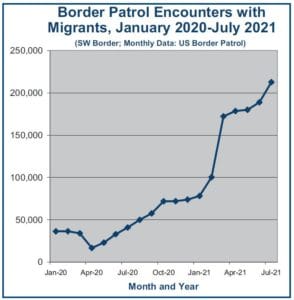How Covid, Climate, and The Cartels Reshape U.S. Refugee Policy
- Edwin S. Rubenstein
- October 25, 2021
- Forum Papers
- Forum Paper
- 0 Comments
Click here for a downloadable, printable PDF version.
An NPG Forum Paper
by Edwin S. Rubenstein
October 2021
The coronavirus pandemic has had far reaching consequences for the global economy, obliterating millions of jobs. And it has affected developing countries disproportionately, setting back decades of progress. So, it’s hardly surprising that agents at the U.S.-Mexico border in 2021 have stopped people from more than 160 countries, a geography that roughly coincides with countries hard hit by the virus.
The graphic traces four distinct phases of the COVID refugee influx:
In the Beginning: At the start of the pandemic the U.S. and Mexican governments shut down their land borders to all non-essential travel. The word spread quickly: The number of illegal border crossers encountered by Border Patrol (BP) agents collapsed from 34,064 in March 2020 to 16,789 in April of that year.
Trump Invokes Title 42: The executive order, invoked by President Trump in March 2020, allows BP agents to waive formal apprehension and expulsion procedures. Encounters rose modestly from April 2020 to the end of the Trump administration, but more than 80% of them resulted in expulsion rather than apprehension.1
The Early Biden Period: An overly-optimistic President practically declared the pandemic over, his people reportedly planning to terminate Title 42. Expulsions were less common – and apprehensions more common – in the first months of his administration. Saner heads warned that ending expulsions would lead to an even larger surge of illegal immigration at the border – and this scenario has proven correct. Border Patrol encounters exploded from 78,323 in January 2021 to 172,331 in March; by July Border Patrol personnel reported more than 200,000 encounters with illegal migrants – the highest monthly total in more than two decades.
July 2021 – The Delta Variant Forces a Reversal:
“LOS ANGELES — The Biden administration announced late Monday that it would begin swiftly removing migrant families that immigration officials determined did not qualify for asylum after an initial screening at the southwestern border.” – New York Times, July 26, 2021
The highly contagious Delta Variant forced the administration to endorse the same Title 42 protocols it had just rejected. But saying it and doing it are two different things. Record numbers of illegal border crossers had already entered the country in Biden’s first few months, claiming persecution awaits them in their home country. Adjudicating those claims can take years, by which time most illegals will have created a new life for themselves.
Biden’s immigration team claims they can shorten average wait times to a matter of weeks by allowing asylum seekers to appear before asylum officers rather than immigration judges.
“Whether it’s weeks or years,” Mark Krikorian warns, “unless asylum applicants are held in detention, they’re not going to leave if they lose… There is no possibility of regaining control over immigration without either detaining all asylumseekers until they receive a decision, and deporting those who don’t qualify, or making them wait in Mexico for their hearing date. The Biden administration refuses to do either…”
LIES, DAMN LIES, AND (BORDER PATROL) STATISTICS
Since the passage Title 42 the Border Patrol has deployed a new statistic – “encounters” – to measure the total number of people processed by BP personnel. As described above, under the new order Border Patrol agents are no longer required to conduct formal apprehension and removal procedures, but can send border crossers back to Mexico without those steps.
One unintended consequence of the expulsions spike has been an increase in repeat border crossers. In July 2021, 27% of all Border Patrol encounters involved migrants with at least one previous encounter within the past year. That was up from an average of 14% over the 2014 to 2019 period, before Title 42 took effect.3
In July, there were 212,672 total encounters along the Southwest border, but only 154,288 unique encounters.4 The difference – 58,384 border crossers – are individuals who were apprehended more than once. Total encounters is a good measure of the work effort put forth by BP personnel, while unique encounters measures the net impact of their work in reducing U.S. population growth.
By increasing the number of repeat crossers, Title 42 has reduced the efficiency of BP personnel. An increasing share of their time is spent processing people who, in prior years, would not have been allowed to enter…Continue reading the full Forum paper by clicking here.
Ed Rubenstein, president of ESR Research, is an experienced business researcher, financial analyst, and economics journalist. He has written extensively on federal tax policy, government waste, the Reagan legacy, and – most recently – on immigration. He is the author of two books: The Right Data (1994) and From the Empire State to the Vampire State: New York in a Downward Transition (with Herbert London). His essays on public policy have appeared in The Wall Street Journal, The New York Times, Harvard Business Review, Investor’s Business Daily, Newsday, and National Review. His TV appearances include Firing Line, Bill Moyers, McNeil-Lehr, CNBC, and Debates-Debates. Mr. Rubenstein has a B.A. from Johns Hopkins and a graduate degree in economics from Columbia University.


